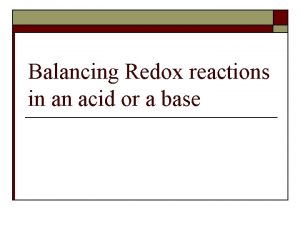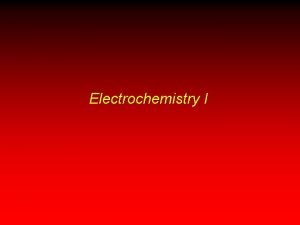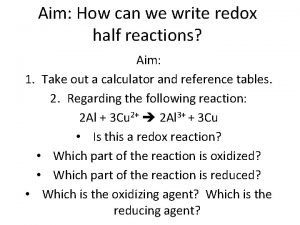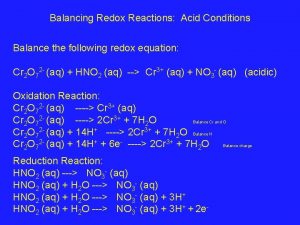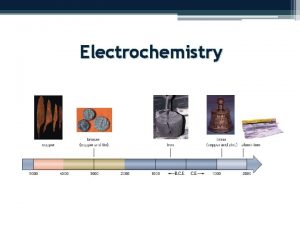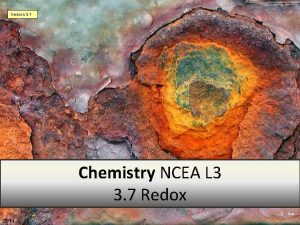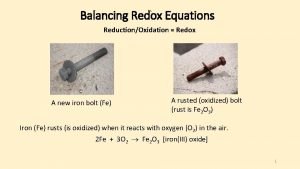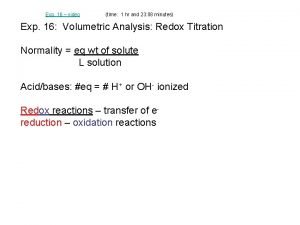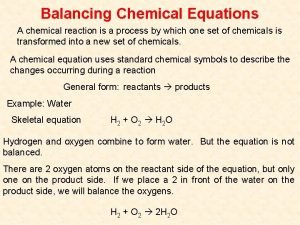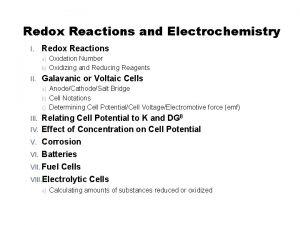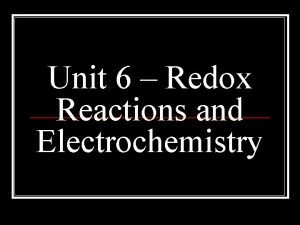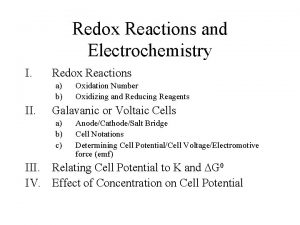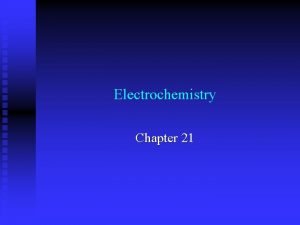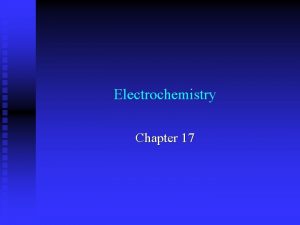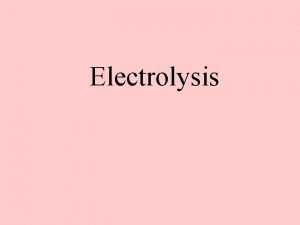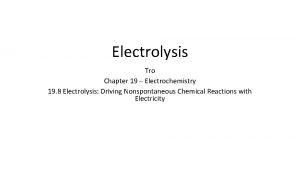electrochemistry v redox reactions cells v electrolysis M





















- Slides: 21

electrochemistry v redox reactions ( cells ) v electrolysis M. Morelli I. T. I. Malignani - Udine

redox oxidation is : • addition of oxygen • loss of hydrogen • loss of electrons • an increase in oxidation state M. Morelli reduction is : • loss of oxygen • addition of hydrogen • addition of electrons • a decrease in oxidation state I. T. I. Malignani - Udine

a simple reaction will serve to demonstrate: oxidation and reduction if we immerse a piece of solid copper in a colourless silver nitrate solution, we can tell that a chemical reaction occurs because the solution turns blue and we can notice a silvery coating that forms on the piece of copper after 5 minutes M. Morelli I. T. I. Malignani - Udine

what is the nature of this chemical change ? you known that copper (II ) ions in solution are blue, so copper ions (II) must be forming and the silver nitrate solution contains silver ions ; these ions form the solid silver-coloured material ; the unbalanced reaction between solid copper and silver ions is this : Ag+ (aq) + Cu (s) Cu 2+ (aq) + Ag (s) This equation tells you that solid copper atoms are changing to copper ions at the same time that silver ions are changing to solid silver atoms; The reaction opposite can be split into half equations which show what is being reduced and what is being oxidised: Cu (s) Cu 2+ (aq) + 2 e- loss of electrons = oxidation Ag+(aq) + e- Ag (s) gain of electrons = reduction The global reaction is called redox M. Morelli I. T. I. Malignani - Udine

summary Redox are the transfer of electrons from one reactant to another • when there is an oxidation, there is also a reduction. • the substance which loses electrons is oxidised. • the substance which gains electrons is reduced M. Morelli I. T. I. Malignani - Udine

Electrochemical cells an electrochemical cell is : - a chemical system in which an oxidation-reduction reaction occurs spontaneously; -the transfer of electrons is used to produce an electric current; the cell voltage is a measure of the tendency of electrons to flow; if two substances have a great difference in their tendency of lose and acquire electrons, the voltage of the cell will be high ; cell voltage can be used to predict whether a particular redox reaction will occur spontaneously ; -Electrochemical cells that use an oxidation-reduction reaction to generate an electric current are known as galvanic or voltaic cells. M. Morelli I. T. I. Malignani - Udine

an example of voltaic cell is shown below: H+ ions flow toward the cathode, where they are reduced to H 2 gas ( cathode ). On the other side of the cell, the zinc metal is oxidized becoming Zn 2+ (anode ). The electrode at which reduction occurs is called cathode. The electrode at which oxidation occurs is called anode. M. Morelli I. T. I. Malignani - Udine

To provide a basis for comparing the results of one experiment with another, the following set of standard-state conditions for electrochemical measurements has been defined: - solutions are 1 M. - gases have a partial pressure of 0. 1 MPa ( 1 atm). - standard-state measurements are taken at 25 o. C. Cell potentials measured under standard-state conditions are represented by the symbol Eo. The standard-state cell potential Eo, measures the strength of the driving force behind the chemical reaction. The larger is the difference between the oxidizing and reducing strengths of the reactants and products, the larger is the cell potential. M. Morelli I. T. I. Malignani - Udine

Example: the experimental value for the standard-state cell potential for the reaction between zinc metal and acid is 0. 76 volts. Zn(s) + 2 H+(aq) Zn 2+(aq) + H 2(g) Eo = 0. 76 V the cell potential for this reaction measures the relative reducing power of zinc metal compared with hydrogen gas. But it doesn't tell us anything about the absolute value of the reducing power for either zinc metal or H 2. We therefore arbitrarily define the standard-state potential for the reduction of H+ ions to H 2 gas as exactly zero volts. 2 H+ + 2 e- H 2 Eo = 0. 00 V this reference point is used to calibrate the potential of any other halfreaction M. Morelli I. T. I. Malignani - Udine

the overall cell potential for a reaction must be the difference of the potentials for the reduction and oxidation half-reactions Eocell = Eored – Eoox If the overall potential for the reaction between zinc and acid is 0. 76 V, and the half-cell potential for the reduction of H+ ions is 0 volts, then the half-cell potential for the oxidation of zinc metal must be 0. 76 V. Zn 2+ + 2 e- Eoox = 0. 76 V 2 H+ + 2 e- H 2 Eored = 0. 00 V ¯¯¯¯¯¯¯¯¯¯¯¯¯¯¯¯¯¯¯¯¯ Zn + 2 H+ Zn 2+ + H 2 Eocell = Eored - Eoox = 0. 76 V M. Morelli I. T. I. Malignani - Udine

a Daniell cell is an example of a voltaic cell used as a battery. the model of Daniell cell is : the reaction that occurs in this cell is: Zn(s) + Cu 2+(aq) Zn 2+(aq) + Cu(s) Electrons flow from the anode to the cathode in a voltaic cell. They flow from the electrode at which they are given off to the electrode at which they are consumed. the line notation for a standard-state Daniell cell is written as follows: anode (-) Zn | Zn 2+(1. 0 M) || Cu 2+(1. 0 M) | Cu(+) catode Reading from left to right, this line notation therefore corresponds to the direction in which electrons flow. M. Morelli I. T. I. Malignani - Udine

classwork can you describe the problem in your own words ? • draw a concept map for the term electrochemical cell include the following terms : anode, cathode, electrode, oxidation , reduction, salt bridge, voltage and cell • using the table of standard-state potentials answer to these questions : 1 - can aluminium foil immersed in an electrolyte solution be used to restore the lustre to silverware? justify your answer by using the cell potential ( assume 1 M solutions and 25°C) 2 - can a zinc strip immersed in an electrolyte solution be used to restore the lustre to silverware? 3 - calculate the Daniell’s cell potential M. Morelli I. T. I. Malignani - Udine

laboratory experience 1 - build three different electrochemical cells 2 - complete a detailed diagram of each 3 - determine the half reactions and complete reactions occurring in each cell 4 - calculate the cell potential for each cell. Material 50 m. L beaker (3); zinc strip, copper strip, lead strip wire and clip (2), salt bridge, voltmeter 1. 0 M copper (II) nitrate, 1. 0 M zinc nitrate, 1. 0 M lead nitrate Fill the lines with the correct terms for every cell M. Morelli I. T. I. Malignani - Udine

Electrolytic Cells Voltaic cells use a spontaneous chemical reaction to drive an electric current through an external circuit. These cells are important because they are the basis for the batteries that fuel modern society. But they aren't the only kind of electrochemical cell. It is also possible to construct a cell that does work on a chemical system by driving an electric current through the system. These cells are called electrolytic cells. Electrolysis is used to drive an oxidation-reduction reaction in a direction in which it does not occur spontaneously. M. Morelli I. T. I. Malignani - Udine

The Electrolysis of Molten Na. Cl An idealized cell for the electrolysis of sodium chloride is shown in the figure below. A source of direct current is connected to a pair of inert electrodes immersed in molten sodium chloride. The net effect of passing an electric current through the molten salt in this cell is to decompose sodium chloride into its elements, sodium metal and chlorine gas. Reactions of Na. Cl (s): Cathode (-): Na+ + e- Na Anode (+): 2 Cl- Cl 2 + 2 e. M. Morelli I. T. I. Malignani - Udine

Difference between electrolytic cells: voltaic cells and Voltaic cells use the energy given off in a spontaneous reaction to do electrical work. Electrolytic cells use electrical work as source of energy to drive the reaction in the opposite direction. M. Morelli I. T. I. Malignani - Udine

The commercial Downs cell used to electrolyse sodium chloride Chlorine gas that forms on the graphite anode inserted into the bottom of this cell bubbles through the molten sodium chloride into a funnel at the top of the cell. Sodium metal that forms at the cathode floats up through the molten sodium chloride into a sodium-collecting ring, from which it is periodically drained. The diaphragm that separates the two electrodes is a screen of iron gauze, which prevents the explosive reaction that would occur if the products of the electrolysis reaction came in contact. M. Morelli I. T. I. Malignani - Udine

The Electrolysis of Aqueous Na. Cl The figure below shows a cell in which an aqueous solution of sodium chloride is electrolysed. Electrolysis of aqueous Na. Cl solutions gives a mixture of hydrogen and chlorine gas and an aqueous sodium hydroxide solution. 2 Na. Cl(aq) + 2 H 2 O(l) 2 Na+(aq) + 2 OH-(aq) + H 2(g) + Cl 2(g) Electrolysis of aqueous sodium chloride is a more important process commercially, because the demand for chlorine is much larger than the demand for sodium. Electrolysis of an aqueous Na. Cl solution has two other advantages. It produces H 2 gas at the cathode, which can be collected and sold. It also produces Na. OH, which can be drained from the bottom of the electrolytic cell and sold. M. Morelli I. T. I. Malignani - Udine

Electrolysis of Water Another example of electrolysis A pair of inert electrodes are sealed in opposite ends of a container designed to collect the H 2 and O 2 gas given off in this reaction. The electrodes are then connected to a battery or another source of electric current. By itself, water is a very poor conductor of electricity. We therefore add an electrolyte to water to provide ions that can flow through the solution, thereby completing the electric circuit. The electrolyte must be soluble in water. It should also be relatively inexpensive. Most importantly, it must contain ions that are harder to oxidize or reduce than water. Reaction : 2 H 2 O(l) 2 H 2(g) + O 2(g) M. Morelli I. T. I. Malignani - Udine

Corrosion : corrosion occurs by oxidation-reduction reactions. When salt is spread on the roads to melt ice, the salt accelerates the formation of rust on car bodies, bridges, and other steel structures; near the oceans, the salt suspended in the air assists in corroding metal objects; in each of these cases the oxidation of the metal to its oxide is central to the corrosion process. M. Morelli I. T. I. Malignani - Udine

Electroplating: electrochemical process for depositing a thin layer of metal on a metallic base. To electroplate an object with a metal “X “, use: - the object as cathode - a strip of X as anode - a solution of a compound of X as electrolyte Objects are electroplated to prevent corrosion, to obtain a hard surface or attractive finish, to purify metals (as in the electro refining of copper), Typical products of electroplating are silver-plated tableware, chromium-plated car accessories. M. Morelli I. T. I. Malignani - Udine
 Redox reactions examples
Redox reactions examples Balancing redox reactions in acid
Balancing redox reactions in acid Voltaic cell components
Voltaic cell components Balancing redox reactions in basic solution
Balancing redox reactions in basic solution Half redox reaction
Half redox reaction How to write redox half reactions
How to write redox half reactions Chapter 19 redox reactions study guide answers
Chapter 19 redox reactions study guide answers Accomplish the concept map on redox reaction
Accomplish the concept map on redox reaction Balancing redox reactions
Balancing redox reactions Redox reactions definition
Redox reactions definition Predicting redox reactions
Predicting redox reactions Redox reactions ncea level 2
Redox reactions ncea level 2 Leo says ger chemistry
Leo says ger chemistry Electrolysis khan academy
Electrolysis khan academy Types of redox reactions
Types of redox reactions Balancing redox reactions
Balancing redox reactions Spontaneity electrochemistry
Spontaneity electrochemistry Chemsheets writing half equations answers
Chemsheets writing half equations answers Electrochemistry balancing equations
Electrochemistry balancing equations Balancing redox reactions
Balancing redox reactions Half equations
Half equations Rules for balancing redox reactions
Rules for balancing redox reactions

